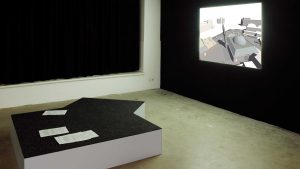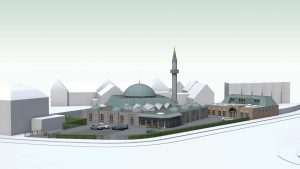Transcriptions of the interviews around the Al Fourqaan mosque at the Otterstraat, Eindhoven.
Person #1 likes the building as it is and doesn’t want to change anything. He wants people to live together in harmony, to be connected and to help each other. Allah has commanded to be good for others. He believes the earth is a temporary home where everyone is being put on test. If you are convicted, if you steal or do other bad things, you’ll be punished in your afterlife. He believes that God sees everything and makes notes. He personally suffers from the bad reputation Muslims have in the Netherlands. He likes to help people, to talk with them and come together. It is his dream that the Netherlands will become a place driven mainly by good intentions.
Person #2 believes the shape of the mosque is subordinate to the content. The main reason why he is visiting this particular mosque is because the imam preaches very well. In his view it is important that everyone feels welcome to visit it. The appearance of the building could be more inviting in his view. Therefore, he suggests to put lightboxes on the pillars placed next to both the entrance for women and the one for men. The lightboxes should depict Medina (the Mosque of the Prophet) and Mecca. A porch with an inscription could connect both of the pillars. The inscription should be: “Marhaba – Welcome”. He also would like to lower the hedge to give passers-by and local residents a better view on the building. He emphasizes that the proposed changes need to be realistic and inexpensive, so that the board of the mosque can actually take them into consideration. But if he allows himself to think without any restriction he would put the entire building on a plateau.
Person #3 thinks the building looks fine. He calls it a multi-functional centre with, among other things, a place for prayer. He lives next to it and the only thing that he would have liked to see is the use of similar colours as within the rest of the neighbourhood. Therefore he suggests giving the mosque green walls like his own housing block.
Person #4 does not recognize the building as a mosque. She suggests making the dome and minaret a bit higher. As the building is too geometric in her point of view, she opts to add some curves. For example she would like to see some small domes surrounding the big one.
Person #5 is satisfied with the appearance of the mosque. He only wants to make a practical proposal. He says that the prayer room for women is too small. He therefore proposes an expansion of the first floor on the left side of the entrance for men. This expansion needs to be supported by pillars. The men could meet and chat underneath it before and after the prayer and would function as a shelter when it rains.
Person #6 prefers not to have a mosque in her neighbourhood. The informal trade annoys her on Fridays. She tells us that ‘they’ sell vegetables, eggs, meat and fish from their cars. She also complains about the separation between men and women. She gets the impression that the Netherlands ended up in the year zero and therefore she feels like a stranger at home. Person # 6 thinks the building is ugly and proposes to demolish it. Though she would like to keep the minaret as a nice decorative element.
Person #7 would like to make the building white with some green elements. She thinks the minaret should be more like a tower and made from stone, similar to the ones in Morocco. Though she thinks the building should have a modern look, so it would suit the Dutch landscape better.
Person #8 thinks the building is not accessible enough. The building has an important function in the neighbourhood and therefore it should be more visible. He refers to the increase of Islamophobia caused by Geert Wilders. He thinks transparency could prevent further segregation. According to him society as a whole should become more transparent. Dutch citizens should learn how to live together. In his view the idea of an open society should be translated into architecture. He proposes to lower the hedge, enlarging first floor’s windows and a gallery with large windows on ground level.
Person #9 thinks the building is ugly. The grey colour is depressing and everything looks messy. She suggests giving the entire building another colour. She prefers yellow ochre. In her view the religious identity of the building should become more visible. She suggests adding mosaics.
Person #10 thinks the building looks very chaotic. She proposes to enlarge the dome and the minaret, because in her view religious buildings should reach out to the heaven. For all the walls she opts the use of yellow ochre bricks and brown horizontal lines.
Person #11 doesn’t like the building and is unhappy with the presence of a mosque in her neighbourhood. She informs us that the mosque has a bad reputation because of the former imam, who had radical fundamentalist ideas. Several years ago the mosque was in the news due to several problems. According to her the neighbourhood is deteriorating. People throw their junk on the street nowadays. She blames the community around the mosque for this behaviour. She does not want to change the building, but she would like to educate the users of the mosque how to behave in a more appropriate manner.
Person #12 thinks the mosque should be bigger. This is a practical proposal because many people come to the mosque on Fridays. He does not want to change the appearance of the building. Content is much more important than appearance, he says.
Person #13 thinks the building doesn’t look very nice, although he enjoys coming there every day. If he had the opportunity to change something, he would highlight the religious identity of the building. He would make the walls green and the dome and minaret white. In addition, he would replace the rectangular windows by arched windows and he would add handmade decorations like woodcarvings.
Person #14 states that a mosque doesn’t fit the Dutch landscape. He wants to demolish the building but complains that it’s unfortunately not up to him.
Person #15 thinks the building should be more recognizable as a mosque. Therefore he proposes to enlarge the dome and minaret.
Person #16 thinks it is a beautiful building but he would like to remove all functional elements like the air conditioning, fire escape, drainage pipes and wiring. These things give the building a messy appearance.
Person #17 would like to enlarge the building and replace all the rectangular windows by arched windows. He also imagines an arched gate at the entrance. Due to Dutch regulations the minaret and dome are not allowed to be any bigger. He expects that the regulations for the construction of mosques will be even stricter in the near future.
Person #18 would like to replace the mosque by a new apartment building. This complex must look modern. The building she proposes should look like the new apartments built in a nearby neighbourhood. In her opinion there are already too many mosques in Eindhoven. She complains that a lot of churches have been demolished. She thinks these churches are our cultural heritage and should be saved, instead of building more mosques.
Person #19 proposes to create a more coherent building. To achieve that he suggest transforming the mosque to a trapezoid shape building. The ground level should provide a substantial basis for a smaller first floor, followed by a smaller dome. For all walls, he suggests to use beige bricks. He would like to reduce the number of windows because the users of the building don’t need that much light. He would like to place the minaret on top of the dome.
Person #20 thinks the building is not very inviting. She suggests moving the entrance and minaret to the side of the parking place. This way it would be clear from a distance that it is a mosque. Also, she opts to remove the fence and hedge around the building. The mosque community is very closed in her opinion. She admits feeling a little anxious during the celebration of religious feasts because the men wear long robes and the women are often completely covered. In her view this can be threatening, especially in the dark. Therefore she proposes to illuminate the mosque at night. In addition she would like to replace the ugly blue emergency staircase by one made of stone.

